Interview by Göksu Kunak in Berlin; Thursday, Aug. 06, 2015
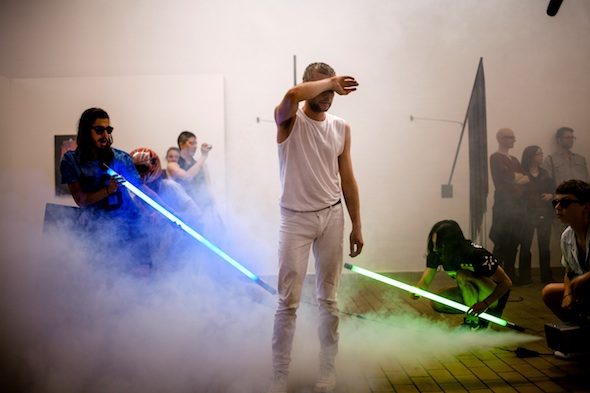 Julian Weber – “the tourist” (2015); Courtesy of the artist and Berlin Art Prize
Julian Weber – “the tourist” (2015); Courtesy of the artist and Berlin Art Prize
Sleek surfaces, pastel colors, minimal forms and abstract ideas; small head ventilators, watermelons, kitsch waterfall posters. A vibraphone played by a classical musician wearing old-school roller skates transforming into a performer with white sneakers sampling 90s hip hop live in another space…
Unexpectedly, such contrasts intersect and merge with each other in a clear form in the works of sculptor, dancer, and choreographer Julian Weber. Weber constructs his intricate choreographies using the codes of conduct determined by the lay of the land of exhibition openings or, say, a day on the beach. His recent choreography ‘the tourist’ (2015) – embellished with steam, all the isms of history of art, and the clichés of tourists visiting big cities – won this year’s Berlin Art Prize.
After a long day of working on his new piece ‘Constructing Ruins’ in the white, clean, industrial space of District Berlin, Weber and I met over falafel in Wedding.
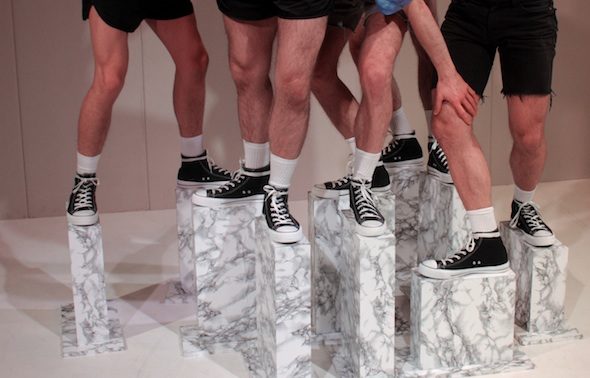 Julian Weber – “Museum der Repliken 2” (2015), Performance: Timo Müller, Jefferson Arcer, Zack Bernstein, Stuart Meyers, Gerard Reyes; Courtesy of the artist
Julian Weber – “Museum der Repliken 2” (2015), Performance: Timo Müller, Jefferson Arcer, Zack Bernstein, Stuart Meyers, Gerard Reyes; Courtesy of the artist
Göksu Kunak: After studying sculpture, how did you decide to become a dancer-choreographer?
Julian Weber: When I get this question I often say: it happened. For sure, I made some decisions, however I surprised myself as well, I have to say. Things came together by coincidence.
Looking back now, I remember already having a physical approach towards making sculptures. There were moments that I was interacting with objects, although I wasn’t considering seriously including dance in my practice or choosing movement as my artistic language. In fact, something was missing. I basically felt bored alone in my studio with my material. As a hobby, I was doing contact improvisation. This was really just a personal pleasure. Therefore, I had a certain connection to the body. By chance, I heard about this new study program (actually, we were the first official graduates of the school). Back then, although I was enrolled at HBK Braunschweig, I was living in Vienna for an exchange and wanted to move to Berlin too.
In the audition for the HZT, it was the first time in my life I performed in front of someone. As I have said, it just happened. I didn’t think so much about it. The first year was tough, though. I was constantly questioning myself. I had doubts about my decision to stop my visual arts studies abruptly. I was feeling so exposed as well. Always being intimate with this group of 15 people…it was a really strong shift. Finding myself in this 9-to-5 study was another aspect of it. Before, I was totally free. Yet, through time, I got used to it.
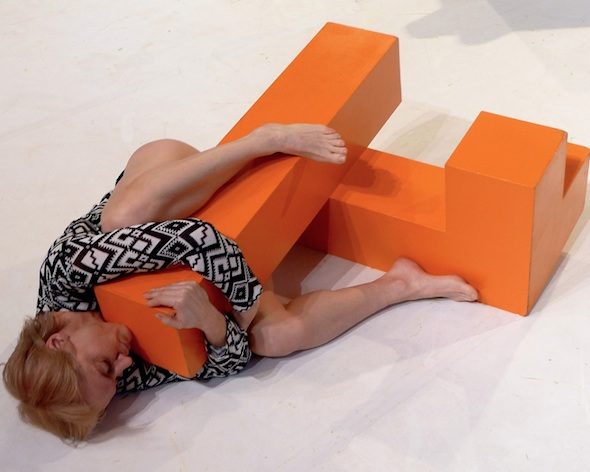 Julian Weber – “Formen Formen” (2015); Courtesy of the artist
Julian Weber – “Formen Formen” (2015); Courtesy of the artist
GK: How do you think your background in sculpture effects your choreographies?
JW: It is not necessarily something that I’m forcing. Naturally, it comes as a result of my background. Often, I simply start from the object. ‘Formen Formen’ is the best example. I have a really strong interest in forms and colors and how these relate with the space.
My choreography is clearly influenced by an interest in the institutions of visual art and dance and the different forms of presentation that come along with them. Usually sculpture, or say, visual arts in general takes place in an exhibition space. The perspective of the audience in such spaces − how the object is consumed and perceived − reflects my thinking. I often see the dance or choreography as if it is an exhibition. I’m super interested in intersecting, merging different contexts. All institutions have conventions and I’m not against that. On the contrary, I find these really interesting. On the one hand, in a traditional theatre, there is a time commitment determined by the artist’s decision: the beginning and end of a piece is pretty clear. You sit and look through a point of view – physically, I mean. On the other hand, in an exhibition, the audience decides from which direction to look or how much time to invest. You have the Allansicht, a German word describing a 360-degree view. What I try to do is to play with such habits and codes of dealing with time and space, infusing the conventions of the exhibition into the theatre space and vice versa.
GK: As a part of Boris Charmatz’s ’20 Dancers for the XX Century’ (2015) you performed at Tate Modern and recently in Tino Sehgal’s piece at Martin Gropius Bau. How do you think the recent interest of museums in dance changes the notion of time and space in contemporary dance/movement?
JW: Even in the museum space, inevitably, there is the beginning and the end of a performance. Nevertheless, considering the difference, the notion of time is stretched in a museum. The duration of an exhibition is normally three months: the standard dance piece is around an hour. In the history of performance, the play with duration is not new of course. But now, by going into the museum, I think it gives a certain kind of value. Rather than being a decoration of an opening of an exhibition or an event, dance, the body and the movement can fill the whole museum. The value changes by showing a dance piece for several months by emptying out the museum space of the other objects.
In Martin Gropius Bau, for Tino Sehgal’s work, I’m performing ‘Kiss’. It is a choreography in which every movement is set. We are definitely an object without having any power to make decisions as a performer. We basically carry out the instructions. Personally, when I’m doing my own work and I’m dancing, I always have a certain interest in having an exchange between me, the other performers and the audience.
In the work by Boris Charmatz, the 48 hour piece was referring to artists and dancers from the 20th Century. The performers had a lot of freedom. I was improvising with the material of the work with Meg Stuart, and Oskar Schlemmer‘s ‘Stäbetanz’. The artworks in the space, the audience and the architecture of the space were my references. What I was basically doing was taking these as the source of my movement. Often it was not clear for the museum visitors if I was performing or not. As soon as a performance occurs, the audience creates a stage as the holy space that no one but the performer can enter without becoming a performer themselves. I do it myself when I see a performance, this behavior is so inscribed in us. We, as the audience, would like to give that space as a respect. Anyways, once we came back to this convention again, it was so engaging for me. I could make use of these established borders by stepping in and out of this abstract space. Actually, the audience became involuntary collaborators.
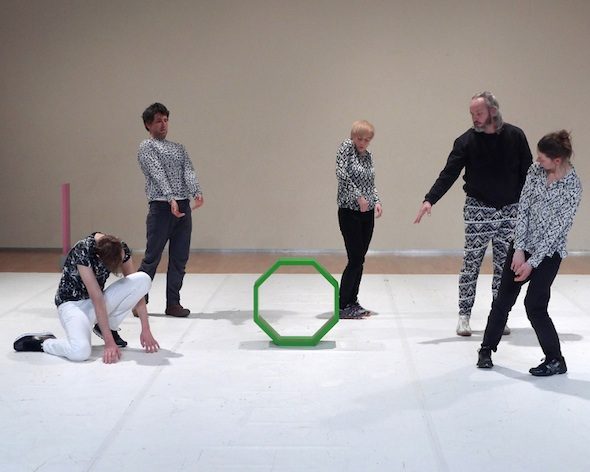 Julian Weber – “Formen Formen” (2015); Courtesy of the artist
Julian Weber – “Formen Formen” (2015); Courtesy of the artist
GK: For ‘Formen Formen’ (2015), Nik Haffner, Hermann Heisig, Peter Pleyer, Meg Stuart, and Claudia Tomasi lived with the personal sculptures you produced for a couple of months, influenced by the notion of object love. After this interaction, how did these objects influence the physicality and movement of the dancer’s bodies?
JW: I hoped and I think it definitely influenced the movement quality. All those objects were my response to the dancers, towards what I know about their body, personality and environment. The sculptural response could go in different directions. I could have chosen to create a strong contrast to that person. Peter (Pleyer), who has more volume, got a long thin sculpture, as an obvious example. The extreme would be to emphasize and support the character of this person. Even the little information that I got from them directed me a lot. The first time I told Meg (Stuart) about the project, her first reaction was that the sculpture has to be stable, because her son will play with it. He will use it as a toy. That was a detail I gave importance to. As I know that Meg was shifting, changing a lot in short time periods, her sculpture was the most complex one. The idea of supporting a quality that is already there was the other possibility. Besides that, all of them had something in common. The sculptures weren’t pleasing at all, weren’t easy to relate to: heavy, clean, cold and with an abstract form. They were reminiscent of minimal art works in a museum, which are always distant and you cannot touch them. I wanted to have a confrontation with the body. The organic, flexible, transforming body meeting sleek surfaces, clarity, reduction and abstraction.
The sculptures simply allowed and forced several actions, movements. It was impossible for Hermann (Heisig) to carry the big black by himself. How he dealt with it and what kind of a solution he came up with for this problem was very informative for the work. I set a clear and quite strict frame by making certain decisions, such as asking them to spend a long time at home with these sculptures. They had to develop a minute of choreographed dance as a response, however it was up to them what kind of material they would create. And, in the end, whatever they came up with for this minute was right, and then shaped the basic material for the choreography.
I wanted to see all those diverse personalities from various perspectives that influence me and my work. Rather than just simply presenting them, I wanted this detour, a complication through dealing with the sculpture. By studying this abstract object and the way they would find their individual solution, each performer would reveal something personal without me pointing it out as the choreographer.
 Julian Weber – “Forcing Things to Relate” (2015); Courtesy of the artist
Julian Weber – “Forcing Things to Relate” (2015); Courtesy of the artist
GK: It seems that collaboration and exchange of ideas are important aspects of your pieces. You give weight to working with people from several disciplines, inviting them to perform together. Who is a part of the performance and who is there just to watch? How do you define collaboration in relation to your practice and the impact of the audience?
JW: Collaboration…I think it is seriously complex. It is a big topic in itself that might be already enough to make a work about it. Collaboration can be the core of the piece. The work can be mainly about the question: what does it mean to collaborate? How can we have non-hierarchal structures and so on?
I am not so interested in this, although I’m not against it. Constructing a choreography, bringing a vision into form and creating products are more appealing to me. First of all, for me, it is important to distinguish between my own artistic work and the role of organizing events where I invite people from different backgrounds, like the Fight Club. Still the borders are not always so clear. In general I like to set frames and invite people. I enjoy being in different roles in a creation process. I like being the person who is in charge of the bigger picture, the vision, balancing the restriction and freedom that will be given to the collaborators and making their strengths become visible. I enjoy being inside the role of the performer as well as being one part of a bigger group. Then, in such a position, because you are not in charge of all decisions, you can concentrate on the role of the performer in a more specific way.
GK: Some weeks ago the biggest ‘Fight Club’ (since 2014), with 28 dancers/performers and 7 musicians improvising together, took place. Could you say more about the idea behind ‘Fight Club’?
JW: The ‘Fight Club’ was an off-space in Berlin Wedding that functioned as my studio and performance/exhibition venue. On an irregular basis, I organize these events − also called Fight Club − in which we try out different formats of improvisation mainly in dance and sound. The Fight Club was born out of the desire for a new platform for improvisation. For each episode I invite a different group of artists, often from various generations and backgrounds and try out different structures for improvisation. Again, I’m proposing the frame and bringing people together, but what actually happens in the encounter of these elements is out of my hands. I guess the main idea of the Fight Club is to come together and dance and have fun.
For the last Fight Club, Tanzfabrik hosted the event in the big Studio14 in Uferstudios. There, I had amazing conditions compared to the off-space where it started; literally only one plug was working in the off-space. So, I was playing a lot with the equipment of a real theater and invited many great artists. Every episode of the Fight Club influences the next one. As the last episode was like a big firework and challenged the focus and tuning of the artists a lot, the next one will definitely be smaller, intimate and more focused.
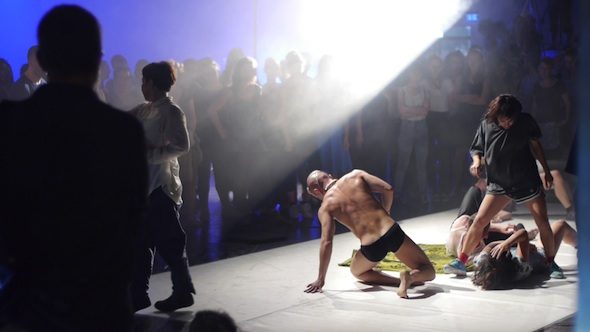 Julian Weber – “Fight Club”, July 16th, 2015; Photo by Martin Hiendl, Courtesy of the artist
Julian Weber – “Fight Club”, July 16th, 2015; Photo by Martin Hiendl, Courtesy of the artist
GK: Now you are in a residency at District Berlin’s space. What are you planning to do there?
JW: For ‘Constructing Ruins’, I will continue and deepen my investigation of possible interaction spaces between dance and sculpture; the mix of an exhibition and a stage piece. I work with the notion of catastrophe. I am developing sculptures out of aluminum pipes and clay: a very simple and direct technique that allows me to construct structures quickly. Monumental architectural elements are brought into space just by their outer lines. As a result of the choice of materials and reduced construction of the objects, these structures are light and fragile, despite their size. The sketchy, fragile sculptures offer − beside the space itself − the friction surface and the material on which the volatile power of the dance can condense and manifest. Through the dance, the sculptures are activated and constantly shifted in relation to the space. The sculptures and their accidental forming and falling will engage in the choreographic setting and influence the composition. There will be no classical stage and no tribune. The audience can move freely and is involved in the spatial changes. They might have to dodge, by being pushed into a corner, for instance. Through that, the audience becomes, themselves, the moving material.
___________________________________________________________________________________
Additional Information
DISTRICT BERLIN
“Work in Progress” – JULIAN WEBER
Performance: Thursday, Aug. 6, 2015; 8PM
Bessemerstraße 2-14 (click here for map)
___________________________________________________________________________________






















